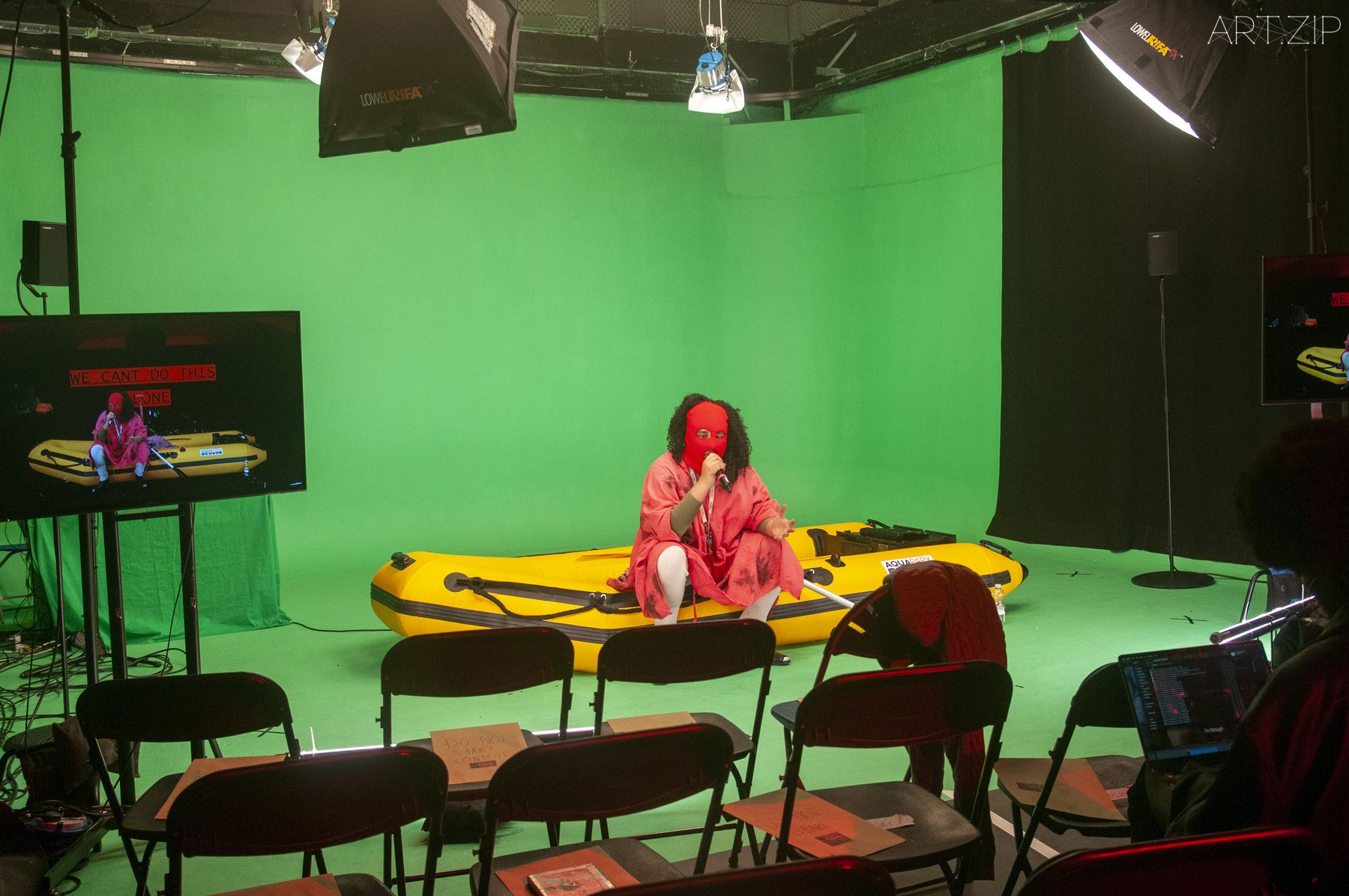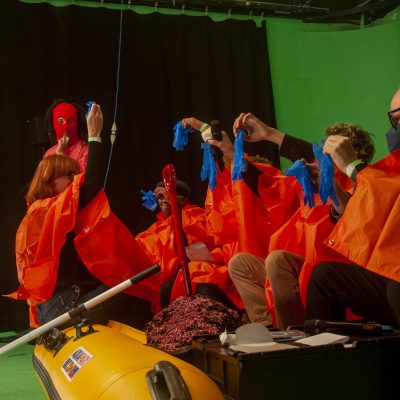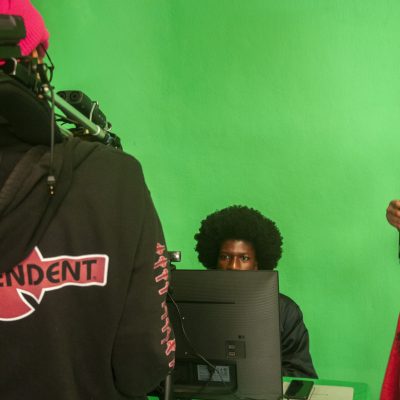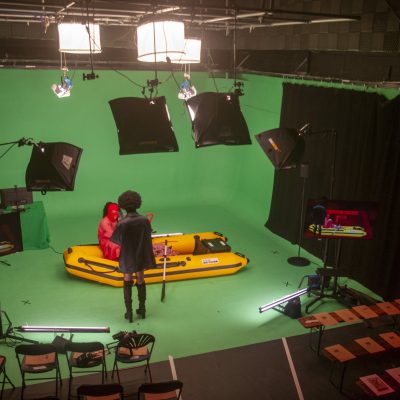
Artist and game designer Danielle Brathwaite-Shirley held an intimate playtesting event, WE CAN’T DO THIS ALONE, in south London on 11 April 2022. The event followed a six month period of research and development (R&D) with Serpentine’s Arts Technologies team where she and developer Rob Prouse employed surveillance technologies such as motion capture, facial recognition and eye-tracking to create game interactions where players’ presence, movement and identity act at a game controller.
WE CAN’T DO THIS ALONE marked a chance to test these prototypes with the public in a new game experience. On entering the event’s location––a chroma-key green studio with cyclorama walls––audience members were guided to their seats by balaclava-clad ushers, the artist’ agents. They found the artist singing on an inflatable boat set against a green-screen stage, with the studio divided into two parts on either side. Several cameras were pointed around and the audience had been told before arrival that their every motion would be recorded. Two monitors in front of the stage displayed the in-game action to the seated audience, keying in the game engine’s real-time visuals via the greenscreen. Danielle wore a red mask and muffled her voice with the help of a vocoder (voice changer). On their seats, the audience found an envelope, indicating their role and task for the duration of the show. It also warned that this information should be kept absolutely confidential.
As the evening began, audience members learned that they were cohabitants of a village with six clairvoyants (selected from the audience by the artist). Following the murder of one of the clairvoyants by another, it’s the audience’s task to find out who the killer is by asking the five remaining clairvoyants questions. It’s up to them to collectively decide the killer’s identity, those in the community who need to be protected, and determine how to protect them. The audience’s actions and inputs promoted and shaped the development of the play’s activity. Throughout, audience members discussed the mystery with the people around them, trying to solve it with further clues that prompted them to play both within and outside of the virtual game world, at one point scanning their faces into characters and at another point using their eyes to navigate clues. Throughout, the audience themselves faced inquisition and limited time, each one suspicious of the other, and just as the artist designed. Although the killer wasn’t found at the end of the show, the social construction simulated by this performance and the wider core issue it addressed:supremacy, is still worth thinking about after the event…
AZ: This is a thought-provoking and memorable event that adopts game interaction approaches to stimulate people’s interests, thus leading audiences to deeply ponder issues around supremacy, communities, and responsibilities. The event reminds us of a game called Mafia, also known as Werewolf, which was released in 1986 and became popular again in Asia not long ago. The rules of that particular game also require players to find out the lying werewolf through their judgments and votes. Was your inspiration for the event derived from such game analogues? What was the genesis of your project?
D:Yes and no. During the pandemic, a game called Among Us was really popular. Among Us is similar to Werewolf but it’s played online, and includes elements like having to do tasks and claim your innocence. There’s something really interesting about having to claim that you are innocent, even though there’s a lot of evidence stacked against you. But originally, when I was planning this, it wasn’t on my mind at all. I had just written this story about six clairvoyants who were like a family, one of them had betrayed the other five, and for that they were killed.
Writing that story made me start thinking about ‘Cancel culture’, how communities can harm each other sometimes, and how your friends and even those closest to you can turn on you. It came mostly from thinking about how people within your particular community can cause you the most harm because they’re the ones that know how to hurt you the best. They know what you’re going through, and they have a similar experience to you. So the project was a mix of trying to figure out how to bring people together but also showing that there could be a wealth of differences between them. Showing that assumptions based on looking at a person or based on a person’s ‘role’ could be completely wrong. Everyone essentially is their own individual, with their own thoughts and continuously shifting mindset. Especially because of the US political situation, but regarding the politics in the UK as well, it made me think a lot about how very open-minded people can become very narrow-minded because of events they go through in their lives. That was the basis for the play.
AZ: This is a very interesting and realistic perspective about how situations change. Every moment could lead to drastically different results. Before the game started, you declared to everyone; ‘This is not a performance, but everyone is a performer.’ You encouraged people to be active. How do you see the engagement with this project? Did participation meet your expectations?
D:Good question. I think I expected the audience to be a little more sheepish than they were, but I think the singing at the beginning helped people become part of the performance. I’m someone who really doesn’t like “passive art”, by which I mean traditional art that has been placed in a gallery for those with wealth, money, or time to enjoy at their own leisure, however they want to. I want to turn the tables and say ‘you have to work in order to enjoy the art’. Enjoying art doesn’t mean that it’s always pleasant. Sometimes it’s an experience that changes you, and sometimes it’s an experience that makes you very uncomfortable. We got feedback that some people did feel very uncomfortable and didn’t necessarily like it. But that’s really good feedback. It’s really interesting that this can be art – that art can make you feel like you don’t want to do it again. I find that to be a more fascinating way of appreciating art, because you’re thinking about yourself, your boundaries, what you want to put up with, what you don’t, and what kind of things make you scared. For example, people are scared of being called a supremacist, a racist, a fascist or transphobic, all these kinds of things. I think it’s really interesting to play with what’s going on there, to bring such anxiety forward and have a conversation about it. Sometimes, because someone might be avoiding scenarios, they aren’t actually enacting or activating those supremacist ideas, those kinds of violences, those anti-particular-people sentiments such as transphobia. But equally through such avoidance, they are also helping to enact and uphold such systems of abuse, so that’s what I was trying to get at.
In terms of audience participation, I didn’t expect a particular kind of engagement this time. The way in which we designed the experience was that engagement is essential for the piece to go anywhere. If no one engages, then no one can see the art. I think having cut-and-dry rules like that for yourself is really good, because you can say, okay, no one’s going to come on stage, well, that means the performance is over. It’s ten minutes in and you’re responsible for the performance being over. That’s the format that I want to play with. You have to put in effort in order for the art to exist. If the art does not exist, then tell the audience to put in effort. Overall I was quite happy with the engagement and I’m excited to see how it will change next time. I’ve learned more about how to encourage participation, also how to give people alternative ways to join in without it feeling like peer pressure.
AZ: You put yourself into the audience and attempt to understand their experiences for the sake of bringing the most out of your work. Some of your work makes people feel scared, and your previous works SHE KEEPS ME DAME ALIVE and BlackTransSea.com made us feel stressed and solemn since they discussed serious issues. This time, the project focuses on issues of supremacy and murder, with characters encountering fatal endings. However, interestingly, the event’s overall atmosphere was playful and upbeat. How did you design for this? Were there any surprises or anything that happened outside of your original plan?
D:It’s a really hard question to answer because most of the play is improvised. Most of it is reacting to the audience, how they’re feeling, the way they’re looking at me, what they say in the room and the general demeanour. I take that as an input as if you’re inputting into a video game; the way someone is sitting, the way someone is acting, the way someone is looking. I’m taking these things as points of access. There’s nothing that didn’t go to plan, but there are a lot of things that weren’t planned that happened.
The format completely changed for instance – the way the audience asked questions in the end was completely improvised, and originally in the script, the clairvoyants answer together, but in the moment I decided that they should answer one by one. The scene where we chose which clairvoyant was guilty was also very different from the scenario planned and completely improvised, with each giving an alibi as to why they couldn’t be the guilty party. There was a lot of stuff that I didn’t expect to happen. The ending was completely unplanned in general, so obviously I also didn’t expect any of that to happen either.
AZ: Did you encounter any challenges while attempting to balance the improvised and non-improvised parts of the event?
D:In the future, I’d like to do even more worldbuilding with the audience, giving them more decisions to shape the world so that they feel even more invested in the course of events. That might include incorporating 3D model elements into the world’s design; for instance the village’s chosen name or shape pops up in 3D so there’s more real-time incorporation and feedback from audience decisions. Or superimposing the audience on a green screen, things like that, in order to position both the audience and the people on stage within this world that we’re creating. I think when you’re working with audience participation, or audience-as-medium as I often say, the more you can embed them into this world, the more it feels like a game, the more free they can feel and be within it. I’d like to get to the point where the audience feels like it’s totally their space to control. I know I’ll make it if I get to halfway through the performance and I can leave. I want the performance to be able to finish without me. That’s really scary, but structuring it that way means that it can hold everyone’s thoughts, feelings and ways of acting, without having to be hosted by the person that originally designed it or set the game in motion, which essentially turns it more into something resembling these games that you mentioned like Mafia. When you know the rules, you know how to finish the game. I’d like to not be able to see the end point at all.
AZ: Could you tell us more about your approach to identity design? In previous works you’ve made, players have to choose a specific identity in order to enter the game.
D:This time around, identities were randomly distributed, with envelopes determining identities placed on the chairs. Usually, I’m so focused on who people are, them having to identify and then essentially categorise themselves. But I didn’t want to do that this time. I wanted people to be able to do that to themselves and to each other, experiencing what it is to enter into that mindset of categorisation and suspicion. I think it’s really interesting when people are sitting in the room and they assume the gender of someone like me. Even though I was wearing a mask, my gential information was assumed. Basically, the play is all about supremacy and the ways that some of these systems live within us.
When you organise with a group of people, they raise their heads and the ‘good’ and ‘bad’ things start coming out. I wanted to create a space that allowed this to happen without me having such a strong influence on what particular structures are. So for instance we got a group that wanted to elect someone to make a decision, and this group chose to vote to achieve this. I thought that was a really interesting decision that happened, the birth of a democratic system. But other groups that we do the play with may choose a completely different way of approaching things. I want to make space for all of those formations and decisions to take place, which is why I didn’t declare identities in the same way with this work.
For similar reasons in future, I’d want there to be a different system for choosing the players, more of a group consensus. This time I chose them by feel, as people were looking at me in the eyes, but I didn’t account for people feeling anxious and the kind of pressure it puts on someone when the main performer asks you to come on stage. So I’m thinking of ways to improve that in the future; such as players picked at random or allowing the first to choose the second and so on.
AZ: Yes, I agree with you. Besides, I also think that the circumstances are different when people play games in real life. For example, players may already know each other before entering the game. The different dynamics between the two would be very interesting to investigate. If players already formed a group before the game even started, the allies and rivals would significantly affect the game.
D:Right, exactly. It would be so interesting if we did this with groups like a school, a basketball team or complete strangers in a park. It’s so interesting what the different dynamics are and could be. So, for example, if you did this with a sports team, then they already have this kind of camaraderie. They’re on a team and know how to play as a team. They don’t have to work so hard to figure things out together, plan together. It would be really interesting to see how that dynamic works. And then at a school, they all know each other, but they don’t necessarily know how to work in a team, so when someone is betraying someone else in-game, they’ll feel it more. They’ll say, ‘I know you, why are you doing that?’ I think it’s really interesting to try to diversify the audience.
Just trying this with one audience isn’t enough. We need to make sure that the audience continues to be as diverse and different as the world needs them to be. It doesn’t work if the whole piece is about interaction, trying to avoid a ‘classic’ art world audience, trying to resist falling into the trap of creating work that is only consumed and doesn’t react back to its audience. We also have to make sure that the audience reflects that sentiment and go for a wider, more participatory, and likely less well-versed-in-art audience.
That’s why a lot of my work is online as well. A lot of it is based on game design. The space is very easily played and accessed and not just found in the gallery, because the type of audience that I’m going for is not the typical art audience. I want to mix up what it means to be making art now and what it means to be trying to accommodate a larger kind of audience.
AZ: Did you try and make the game as realistic as possible?
D:I’m not sure if I did that. Again, because there’s so much interactivity. It depends on the person. So for some people, their interaction within this space probably felt a lot more real than others, which is the point of the performance. Sometimes it brings up a lot of worries and concerns for individuals. For example, if you feel like you might be called a supremacist in real life, you might feel very differently about the idea that someone in the room is going to be called a supremacist or the idea that you have to play the role of a supremacist. Or if you have ever experienced racism, the idea of supremacy coming into this room is quite scary because you might experience it again at that moment. But others might just see it as a game, completely just enjoy the game part of it and not think too much about the theory until something happens.
I think there’s a big gap between how real it was for some people and how it really wasn’t for others, and I also think that’s a super interesting part of it. Again, some people are remembering and re-facing; surfacing emotions, worries, anxieties and memories, and others are just experiencing the game for what it is, for the room that was created and for the world that we’re building. So I think it’s really fascinating as we’re gathering feedback, to see who’s taken it really seriously because of the kind of experiences they have, and who could take it as just a game experience where their most immediate references might be other games, like Mafia for instance.
AZ: At the end of the game, the murderer was not revealed. Is this unrevealed narrative related to your upcoming works?
D:Well actually, half the crowd did know who the murderer was because their envelopes revealed the answer – they just weren’t allowed to tell anyone. The envelopes encouraged these players to deter truth from coming out and so although a lot of the audience were actually calling out the right decision, these other players were arguing against it. I’m sharing this to highlight that there are many more stories and complexities at work than just the question of who the murderer is. There are many more layers to what’s happening. The main work is about stopping supremacy and ending it. We didn’t complete the mission this time around, but it’s about the audience working together as a team to solve the mystery, creating a joint effort and needing everyone to be on the same page in order to try and enact this ending.
Playtesting continued through a live event, YOUR PRESENCE ALONE CHANGES HOW OTHERS BREATHE in May 2022, hosted by @serpentineUK on Twitch. The event played out as an interactive murder mystery directed by paticipants via the chatroom. Danielle, in conversation with Tamar Clarke-Brown (Serpentine Arts Technologies Curator), led this choose-your-own-adventure style event, stopping along the way to answer questions about the story and artist’s practice.
WE CAN’T DO THIS ALONE – Serpentine Galleries
YOUR PRESENCE ALONE CHANGES HOW OTHERS BREATHE – Serpentine Galleries
藝術家兼遊戲設計師Danielle Brathwaite-Shirley於2022年4月11日在倫敦南部舉辦了一場名為“WE CAN’T DO THIS ALONE”的親密式遊戲測試活動。在這次活動之前,Serpentine的藝術技術團隊進行了為期六個月的研發,她和開發者Rob Prouse使用了動作捕捉、面部識別和眼球追蹤等跟蹤技術來創建遊戲互動,使玩家的存在、動作和身份在遊戲控制器上發揮作用。
“WE CAN’T DO THIS ALONE”意味著我們有機會在新的遊戲體驗中向公眾測試這些原型。進入會場 — 一個綠色天幕工作室,觀眾就會在戴著巴拉克拉瓦帽的引座員(藝術家的代理人)的引導下到自己的座位上。他們發現這位藝術家在綠幕背景前的一艘充氣船上唱歌,並且工作室被分成左右兩側。幾個攝像機設置在周圍,而觀眾在到達之前就被告知,他們的每一個動作都會被記錄下來。舞台前的兩個顯示器向觀眾席播放遊戲中的動作,也就是通過綠色屏幕輸入遊戲引擎的實時視覺效果。Danielle戴著一個紅色的面具,在聲碼器(變聲器)的幫助下壓低了她的聲音。在觀眾的座位上,他們發現了一個信封,上面寫著他們在演出期間的角色和任務。並且警告說,這些信息應該絕對保密。
夜晚開始,觀眾們得知他們同住在一個有六位先知(由藝術家從觀眾中挑選)的村子。由於一位先知被另一位殺害,觀眾的任務是通過詢問剩下的五位先知問題來找出兇手。由他們共同決定兇手的身份,社區中哪些人需要被保護,並決定如何保護他們。觀眾的行動和投入促進和塑造了活動的發展。在整個過程中,觀眾們與他們周圍的人討論這個謎題,試圖通過進一步的線索來解決這個謎題,從而促使他們在虛擬遊戲世界內外同時參與進遊戲。有時觀眾的臉會被掃描成角色,有時會用他們的眼睛來引導線索。自始至終,觀眾自己都面臨著審問和有限的時間,每個人都懷疑另一個人,就像藝術家設計的那樣。雖然在節目的最後並沒有找到兇手,但這場表演所模擬的社會建構以及它所要解決的更廣泛的核心問題: 霸權,仍然是活動後值得思考的事情……
AZ:這是一個發人深省、令人難忘的活動,通過遊戲互動的方式激發人們的興趣,引導觀眾深入思考霸權、社區、責任等問題。這讓人想起了1986年發行的《Mafia》,也叫《狼人》,不久前在亞洲再次流行起來。該遊戲的規則同樣要求玩家通過自己的判斷和投票找出說謊的狼人。你這次活動的靈感是來自於類似的遊戲嗎?這個項目的起源是什麽?
D:是,也不是。在疫情期間,一款名為《Among Us》的遊戲非常受歡迎。《Among Us》類似於《狼人》,但它是在線遊戲,包括必須完成任務並聲稱自己是無辜的元素。盡管有很多證據對你不利,但你還得聲稱自己是無辜的,這真的很有趣。但最初,當我計劃這個的時候,它根本不在我的腦海里。我只是寫了一個關於這六個先知的故事。他們就像一家人,其中一個背叛了其他五個,因此他們被殺了。
寫這個故事讓我開始思考“取消文化”,社區有時如何互相傷害,你的朋友甚至最親近的人如何背叛你。它主要來自於你所處的特定社區中的人們如何對你造成最大的傷害,因為他們是最知道如何傷害你的人。他們知道你正在經歷什麽,他們和你有相似的經歷。所以這個項目是一個混合體,試圖找出如何把人們聚集在一起,但同時也表明他們之間可能有大量的差異。這表明基於觀察一個人或基於一個人的“角色”的假設可能是完全錯誤的。每個人本質上都是自己的個體,有自己的思想和不斷變化的心態。尤其是因為美國的政治形勢,但關於英國的政治也是如此,這讓我思考了很多,非常開明的人可能會因為他們生活中經歷的事件而變得非常狹隘。這就是這場遊戲的基礎。
AZ:這是一個關於情況會如何變化的非常有趣和現實的觀點。每一刻都可能導致截然不同的結果。遊戲開始前,你向所有人宣布:“這不是一場表演,但每個人都是表演者。”你鼓勵人們積極參與活動。你覺得在這次活動中人們的參與度怎麼樣? 符合你的期望嗎?
D:好問題。我想我本以為觀眾會比他們更害羞一點,但我認為一開始的歌聲幫助人們成為表演的一部分。我是一個非常不喜歡“被動藝術”的人。這裏我指的是那些被放在畫廊里,供那些有錢、有錢、有時間的人在閒暇時隨意欣賞的傳統藝術。我想反過來說,“為了享受藝術,你必須做出行動”。欣賞藝術並不意味著它總是令人愉快的。有時它是一種經歷改變了你,有時是一種讓你非常不舒服的經歷。我們得到的反饋是,有些人確實感到很不舒服,不一定喜歡它。但這真的是很好的反饋。這真的很有趣,它可以是藝術,藝術可以讓你覺得你不想再經歷了。我發現這是欣賞藝術的一種更迷人的方式,因為你在思考你自己,你的界限,你想忍受什麽,你不想忍受什麽,以及什麽樣的事情會讓你害怕。例如,人們害怕被稱為至上主義者、種族主義者、法西斯主義者或恐變性者,諸如此類。我認為這是一件很有趣的事情,把這種焦慮帶到前面,並就此展開一場對話。有時,因為有些人可能會避免某些場景,他們實際上並沒有實施或激活那些至上主義的想法,那些暴力,那些反特定人群的情緒,如跨性別恐懼癥。但同樣地,通過這樣的回避,他們也在幫助制定和維護這樣的濫用制度,所以這就是我想要探討的。
在觀眾參與方面,我並沒有期待任何特殊的。我們設計遊戲體驗的方式是,用戶粘性對於遊戲的發展至關重要。如果沒有人參與,那麽就沒有人能夠看到藝術。我認為對觀眾自己有這樣簡單的規則是非常好的,因為你可以說,好吧,沒有人會上台,這意味著表演結束了。已經開始十分鐘了,你要為演出結束負責。這就是我想要的形式。為了藝術的存在,你必須付出努力。如果藝術不存在,那就告訴觀眾要努力。總的來說,我對這次的觀眾參與很滿意,我很期待它的下一次改變。我學到了更多關於如何鼓勵參與,以及如何給人們提供參與的替代方式,而免受同輩壓力。
AZ:你把自己置身於觀眾的角度,試圖理解他們的經歷,以便使你的作品發揮最大的作用。你的一些作品讓人感到害怕,你之前的作品《SHE KEEPS ME DAME ALIVE》和BlackTransSea.com讓我們感到壓力和莊嚴,因為他們討論的是嚴肅的問題。這一次,這個項目聚焦於霸權和謀殺的問題,人物遭遇了致命的結局。然而,有趣的是,整個活動的氣氛是有趣和樂觀的。你是如何設計的?有沒有什麽意外或者發生了什麽超出你原計劃的事?
D:這是一個很難回答的問題,因為這次的大部分內容都是即興的。大部分是對觀眾的反應,他們的感受,他們看我的方式,他們在房間里說什麽,以及總的舉止。我將其作為一種輸入,就像你在電子遊戲中輸入內容一樣;一個人坐著的方式,一個人行動的方式,一個人看的方式。我把這些東西作為訪問點。沒有什麽事情是不按照計劃進行的,但是有很多沒有計畫的事發生了。
例如,形式完全改變了——最後觀眾提問的方式完全是即興的,最初在劇本中,是先知們一起回答問題,但在當時那一刻我決定他們應該一個一個回答。我們選擇哪位先知有罪的場景也與計劃的非常不同,完全是即興的,每個人都給出了不在場證明,說明為什麽他們不是有罪的一方。有很多事情是我沒有預料到的。總的來說,結局是完全沒有計劃的,所以很明顯,我也沒有預料到這一切會發生。
AZ:你在試圖平衡這次活動的即興部分和非即興部分時遇到過什麽挑戰嗎?
D:在未來,我想和觀眾一起創造更多的世界,給他們更多的決定權來塑造世界,這樣他們就會覺得自己更投入於事件的發展過程中。這可能包括將3D模型元素融入這個世界的設計;例如,村莊選擇的名字或形狀以3D形式彈出,這樣就可以從觀眾的決定中獲得更多的實時整合和反饋。或者把觀眾疊加在一個綠色屏幕上,諸如此類,為了把觀眾和舞台上的人都放在我們正在創造的這個世界里。我認為當你在研究用戶參與度上時,或者像我常說的那樣將用戶作為媒介時,你越能夠將他們融入這個世界,它就越像一款遊戲,他們就越能夠感受到遊戲的自由。我想讓觀眾覺得這完全是他們的控制空間。我知道如果演出進行到一半我就能走了。我希望演出能在沒有我的情況下結束。這真的很可怕,但這種結構意味著它可以容納每個人的想法、感受和行為方式,而不需要由最初設計它的人來主持或啟動遊戲,這從本質上使它更像你提到的《Mafia》。當你知道規則時,你就知道如何完成遊戲。我希望根本看不到終點。
AZ:你願意告訴我們更多關於你對於身份設計的方法嗎?在你之前的作品中,玩家必須選擇一個特定的身份才能進入遊戲。
D:這一次,身份是隨機分配的,椅子上放著決定身份的信封。通常,我非常關注人們是誰,他們必須表明身分,本質上是給自己分類。但這次我不想這麽做了。我希望人們能夠對自己這樣做,對彼此這樣做,體驗到這種分類和懷疑的心態。我認為當人們坐在房間里,他們推斷像我這樣的人的性別時,是非常有趣的。雖然我戴著面具,但我的基本信息是假設的。基本上,這個遊戲都是關於霸權以及在我們當中這些系統的生存方式。
當你組織起來一群人時,他們擡起頭來,“好”和“壞”的事情就開始出現了。我想創造一個允許這種情況發生的空間,而不是我對特定結構有如此強烈的影響。例如,我們有一個團體想要選舉某人來做決定,這個團體選擇投票來實現這個目標。我認為這是一個非常有趣的決定,民主制度的誕生。但是其他和我們一起表演的群體可能會選擇一種完全不同的方式來處理事情。我想為所有這些形成和決定的發生留出空間,這就是為什麽我沒有在這個作品中以同樣的方式聲明身份。
出於類似的原因,我希望未來能夠有一個不同的系統來選擇玩家,更多的是群體共識。這次我是憑感覺選擇的,因為人們都在看著我的眼睛,但我沒有考慮到人們的焦慮,以及當主角請你上台時給人的那種壓力。所以我在想辦法在未來改進它;比如玩家隨機選擇,或者讓第一個選擇第二個等等。
AZ:是的,我同意你的看法。此外,我也認為人們在現實生活中玩遊戲的情況是不同的。例如,玩家可能在進入遊戲前就已經認識彼此。兩個世界之間的不同動力會是非常有趣的研究。如果玩家們在遊戲開始前就已經組成了一個團隊,那麽盟友和對手就會對遊戲產生重大影響。
D:對的,沒錯。如果我們在學校、籃球隊或公園里一群完全陌生的人中這樣做,那將是非常有趣的。多麽有意思,不同的動勢並將如何變化。所以,舉個例子,如果你對一個運動隊這樣做,那麽他們已經有了這種友情。他們是一個團隊,知道如何作為一個團隊打球。他們不需要那麽努力就能夠一起解決問題,一起計畫了。看看這種動勢是如何運作的將會非常有趣。而在學校中,他們都認識彼此,但並不一定知道如何在團隊中工作,所以當有人在遊戲中背叛別人時,他們會有更多的感受。他們會說,‘我了解你,你為什麽要這麽做?”我認為讓觀眾群體多樣化是一件非常有趣的事情。
僅僅在一個觀眾面前嘗試是不夠的。我們需要確保受眾繼續按照世界的需要多樣化和不同。如果整個作品是關於互動的,試圖避開“經典”藝術世界的觀眾,試圖避免陷入創作只消耗而不回應觀眾的作品的陷阱,這是行不通的。我們還必須確保觀眾反映出這種情緒,並爭取更廣泛、更具參與性、可能不太精通藝術的觀眾。
這就是為什麽我的很多作品也在網上。其中很多都是基於遊戲設計。這個空間很容易發揮和進入,而不只是在畫廊里,因為我要找的觀眾類型不是典型的藝術觀眾。我想把現在的藝術創作的意義和嘗試去容納更多的觀眾的意義結合起來。
AZ:你是否嘗試著讓遊戲變得盡可能真實?
D:我不確定我有沒有那樣做。因為有太多的互動性。這取決於人。所以對一些人來說,他們在這個空間里的互動可能比其他人感覺更真實,這就是表演的意義所在。有時它會給個人帶來很多擔憂和擔憂。例如,如果你覺得在現實生活中你可能會被稱為霸權主義者,你可能會對房間里的某人會被稱為霸權主義者或者你必須扮演霸權主義者的角色有非常不同的感覺。或者,如果你曾經經歷過種族主義,霸權主義的想法進入這個房間是相當可怕的,因為你可能會在那個時刻再次經歷它。但其他人可能只是將其視為一種遊戲,完全享受其中的遊戲部分,在發生某些事情之前不會過多考慮理論。
我認為在對一些人來說是真實的和對另一些人來說並不真實的之間有很大的差距,我也認為這是非常有趣的一部分。同樣,有些人在回憶並重新面對;將情感,擔憂,焦慮和記憶呈現出來,其他人只是為了遊戲本身,為了我們所創造的房間和我們所創造的世界而體驗遊戲。所以我認為收集反饋是件很有趣的事,我們可以通過他們所擁有的體驗來判斷誰真正重視這款遊戲,以及誰會把它當成一種遊戲體驗,而他們最直接的參考對象可能是其他遊戲,如《Mafia》。
AZ:在遊戲的最後,兇手並沒有被揭露。這種未揭示的敘事與你即將到來的作品有關嗎?
D:事實上,有一半的人確實知道兇手是誰,因為他們的信封里有答案——只是不允許他們告訴任何人。這些信封鼓勵這些玩家阻止真相的出現,所以盡管很多觀眾實際上在喊出正確的決定,這些其他玩家卻在反對它。我分享這一點是為了強調,除了誰是兇手的問題,還有更多的故事和覆雜性在起作用。事情的發展還有很多層次。這個作品主要是關於停止霸權並結束它。這一次我們沒有完成任務,但它是關於觀眾一起合作,作為一個團隊來解決謎題,創造了一個共同的努力,每個人都需要站在一起,以嘗試和實現這個結局。
游遊戲測試通過直播活動繼續進行,YOUR PRESENCE ALONE CHANGES HOW OTHERS BREATHE將在2022年5月,由@serpentineUK在Twitch上主持。該事件作為一個互動的謀殺謎團,由參與者通過聊天室推導。Danielle在與Tamar Clarke-Brown(蛇行藝術技術策展人)的對話中,領導了這次“選擇你自己的冒險”風格的活動,在期間中停下來回答關於故事和藝術家實踐的問題。
更多信息:
WE CAN’T DO THIS ALONE – Serpentine Galleries
YOUR PRESENCE ALONE CHANGES HOW OTHERS BREATHE – Serpentine Galleries
Text by Xinde Ren 撰文 x 任心得






